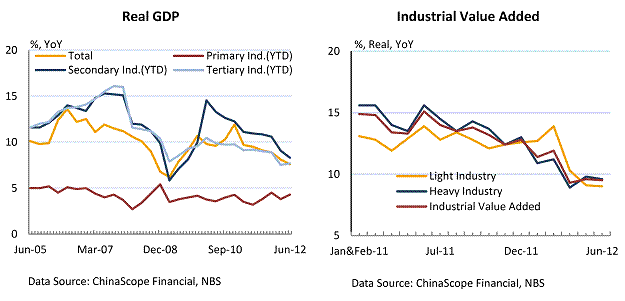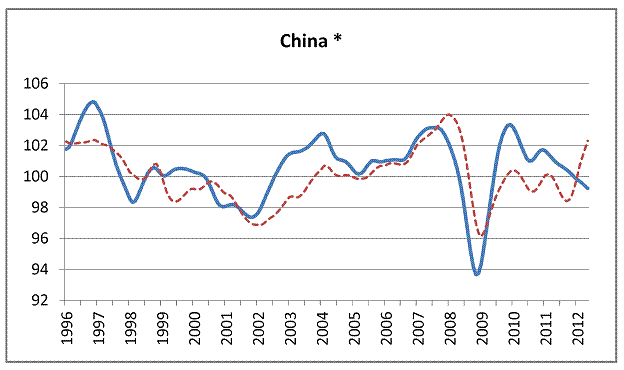Recent economic reports from China are, at the least, mixed. The responses to Friday’s GDP report are illustrative.
From IHS-Global Insight (Xianfeng Ren):
China has reported the worst quarterly GDP growth, 7.6%, in almost three years. This is a less vicious downslide compared with the Global Financial Crisis if measured by peak-to-trough deceleration, but nearly as bad as in the Asian Financial Crisis. The length of consecutive quarterly GDP growth deceleration is even longer than in the slide following the Asian Financial Crisis—six straight quarters of deceleration, vs. five in the Asian Financial Crisis. Domestic macro control and weakening external demand are the causes of the slowdown, but it is policy miscalculation and larger-than-anticipated shock from the Euro Zone which have caused the stalling in Q2. … What is more dismal than the dismal growth is China’s inability to absorb slower growth. A 7.8% growth in the first half already feels quite hard in terms of impact, inflicting huge pain: a downward spiral of producer prices, surging manufacturers’ inventories, plunging profits, bankruptcies and pay cuts.
From Deutsche Bank, “China: decelerating trend in Q2 GDP”:
China’s Q2 real GDP growth slowed to 7.6% yoy (1.8% qoq, sa) after 8.1% yoy in Q1 – the slowest rate since Q1 09 – putting H1 12 growth at 7.8%.
Q2 growth was in line with market expectations. . . . The most likely scenario is marginal easing of property market curbs, further easing in monetary policy to support liquidity and targeted stimulus measures to bring forward some infrastructure projects, with a view to preserving jobs and supporting consumption. This should help to contain systemic risk arising from bankruptcies and defaults. The rebound in H2 is not yet assured, as suggested by leading indicators such as PMI. But we expect public investment, as shown by the recent pick-up in fixed asset investment, to limit the downside.

Source: ChinaScopeFinancial, July 13, 2012.
These assessments are based upon a fairly straightforward reading of the official data. Of course, observers have long cast a skeptical eye on these data. From Thomas Orlick and Aaron Back:
BEIJING — Official data due this week are expected to show growth in China slowing to its lowest rate since the global financial crisis. But some economists say they are turning up evidence that the true picture could be even worse.
…
Economists have responded to long-standing doubts about the reliability of official data by constructing their own indexes of China’s growth. Typically these are based on measures such as electricity production, rail freight and real-estate construction that should track growth closely but are regarded as less prone to political interference.
London-based research firm Capital Economics created its own index during the last major downturn during the 2008-09 crisis. “We created a proxy of Chinese economic activity in order to answer doubts about the data, somewhat to our surprise it generally runs in proximity to the official numbers,” said Mark Williams, an economist at the firm. “But particularly at the beginning of this year they began to diverge. So doubts about the quality of the data are justified.”
Capital Economics’ proxy indicator suggests that China’s economy grew by around 7.6% in the first quarter of this year, half a percentage point lower than the official GDP figure.
Similar results reached by other analysts have led some to suspect that the data are “smoothed” and become less reliable during periods of rapid slowdown or strong growth — times when the margin for error in calculating the true rate of growth also may be higher.
Friday’s numbers will be underpinned by a new approach to collecting data on industrial output, a key measure of China’s growth accounting for about half of GDP.
Under the new approach, in place since February, China’s biggest 700,000 enterprises report data directly to the NBS over the Internet. That replaces a system where many reported to local statistics offices, and information was then transmitted from town, to city, to province and to national levels.
The latest approach is intended to overcome one of the main flaws in China’s data system — exaggeration of the growth rate by ambitious local officials. A notice on the National Bureau of Statistics website in February announcing the change called on businesses to “submit data independently, resisting any attempts at interference.”
China takes on heightened importance because China was one of the bright spots in the world economy, contributing one of the largest increments to world GDP [1]. As illustrated in the IMF’s World Economic Outlook update, released yesterday, forecasts finalized even before Friday’s GDP release marked down in a noticeable fashion. Forecasted 2012 and 2013 y/y growth rates have been reduced by 0.2 and 0.3 percentage points, respectively.
What do the leading indicators suggest? The OECD’s indicate a downturn (where numbers below 100 indicate that growth will be below trend).

Solid blue line: Composite Leading Indicator; dashed red line: index of industrial production. Figure from OECD Composite Leading Indicators (CLIs): Historical Data and Methodological Information – Updated: July 2012: Tables and Graphs.
The OECD CLI for China is designed “to provide early signals of turning points between expansions and slowdowns of economic activity” and uses the following components: Production of chemical fertilizer (tonnes), monetary aggregate m2 (Renminbi), Production of manufactured crude steel (tonnes), 5000 Industrial Enterprises Diffusion Index, Overseas order level (%), buildings (m2), Production of motor vehicles (number), and the Shanghai Stock Exchange Turnover (Renminbi).
Why the dispersion in outlooks? I think it has to do with the difficulty in (1) determining how the leadership will respond to slowing growth, and with which instruments, and (2) how much economic activity will respond to manipulation of those economic instruments, and at what horizon. Item (1) in particular is more amenable to political analysis than economic analysis (for sure, I never learned anything about judging these matters in grad school). However, Eswar Prasad (former IMF China desk head, currently at Brookings) belives that with the transition in the offing, policymakers will do what it takes to hit the targets: “Chinese policy makers are likely to open the taps on both monetary and fiscal policy measures to revive growth momentum in the second half of the year.” … “Given the imminent leadership transition, hitting this year’s growth target is now the key policy priority.”
Returning to the global context, the IMF’s implicit prescriptions make a lot of sense to me, given the euro area and China growth prospects are being marked down. In particular, it is ever more incumbent that the US avoid the fiscal cliff, by extending the stimulative measures (aside from the tax cut for incomes over $250K which do not seem to have a big “bang for the buck”) and avoiding the sequester.
. . .These forecasts, however, are predicated on two important assumptions: that there will be sufficient policy action to allow financial conditions in the euro area periphery to ease gradually and that recent policy easing in emerging market economies will gain traction. Clearly, downside risks continue to loom large, importantly reflecting risks of delayed or insufficient policy action. In Europe, the measures announced at the European Union (EU) leaders’ summit in June are steps in the right direction. The very recent, renewed deterioration of sovereign debt markets underscores that timely implementation of these measures, together with further progress on banking and fiscal union, must be a priority. In the United States, avoiding the fiscal cliff, promptly raising the debt ceiling, and developing a medium-term fiscal plan are of the essence. In emerging market economies, policymakers should be ready to cope with trade declines and the high volatility of capital flows.
The Chinese learned very early how to manipulate GDP numbers for western consumption, but it could be a bit of disaster for China. Most of China’s GDP, obviously, is government spending but more it is essentially being spend as Keynes would love, digging holes and filling them up. The difference is the Chinese are building cities where no one is living.
Here you can see pictures of the Chinese “ghost” cities. And all of this construction cost is part of the government expenditures in GDP.
But the Chinese are even more creative. They are actually going Keynes one better. They are building “ghost” cities in other countries. Anything to keep that GDP up for the benefit of all the gullible western economists.
China is run by the corporations economically and by Putin politically. In many respects, China is what capitalism was trying to do with Russia in the 1917-32 period after Kerensky was rejected by the Russians and instead, they forced in the Bolshevism. Stalin messed up that plan(much to Fred Koch’s chagrin) and rebuilt the Russian Empire on the back of the Soviet Economic Model to it collapsed. Capitalism is going through its abundency crisis at the moment. All that capital out there and no one to absorb it as innovation has slowed to a crawl drying up profits. Steve Keen has this issue down pat. The post-information boom era has not been nice. Similiar to the post-industrial revolution death rattle in the 1920’s which surges credit as the it did in the 2000’s.
It isn’t government spending, but corporate flows inside China(what Ricardo mistakes as “government” spending. China was overgrowing and needed to slow. So they slowed. Big deal. Yeah, they built cities that nobody wants, but in turn, they pay wages to low for people to afford it.
The paradox of thrift by capitalism.
I’m with Ricardo on this one. The China ‘miracle’ while real for a while, is now a monstrous sand castle waiting for the tide to come in. You can create GDP growth out of thin air, but not prosperity. When the psychology changes and assets are revalued, we will see a crash the text books will talk about for centuries.
Rage, there isn’t much capitalism in China. You have forgotten what fascism looks like.
Ricardo has it right. China will not merely slow. Either presently, or after one more burst of Yuan creation/govt spending, China will hit the wall every bit as hard as Japan.